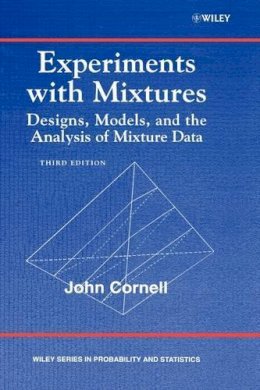
Stock image for illustration purposes only - book cover, edition or condition may vary.
Experiments with Mixtures: Designs, Models, and the Analysis of Mixture Data
John A. Cornell
€ 257.55
FREE Delivery in Ireland
Description for Experiments with Mixtures: Designs, Models, and the Analysis of Mixture Data
Hardcover. With this comprehensive book, readers will learn how to design and set up mixture experiments and then analyze the data and draw inferences from the results. The third edition incorporates in-depth information from over 73 articles, covering the developments of the past decade. Series: Wiley Series in Probability and Statistics. Num Pages: 680 pages, bibliography, indexes. BIC Classification: PBT; PDE; PDN; PN. Category: (P) Professional & Vocational; (UP) Postgraduate, Research & Scholarly; (UU) Undergraduate. Dimension: 244 x 164 x 43. Weight in Grams: 1178.
The most comprehensive, single-volume guide to conductingexperiments with mixtures
"If one is involved, or heavily interested, in experiments onmixtures of ingredients, one must obtain this book. It is, as wasthe first edition, the definitive work."
-Short Book Reviews (Publication of the International StatisticalInstitute)
"The text contains many examples with worked solutions and with itsextensive coverage of the subject matter will prove invaluable tothose in the industrial and educational sectors whose work involvesthe design and analysis of mixture experiments."
-Journal of the Royal Statistical Society
"The author has done a great job in presenting the vitalinformation on experiments with mixtures in a lucid and readablestyle. . . . A very informative, interesting, and useful book on animportant statistical topic."
-Zentralblatt fur Mathematik und Ihre Grenzgebiete
Experiments with Mixtures shows researchers and students how todesign and set up mixture experiments, then analyze the data anddraw inferences from the results. Virtually every technique thathas appeared in the literature of mixtures can be found here, andcomputing formulas for each method are provided with completelyworked examples. Almost all of the numerical examples are takenfrom real experiments. Coverage begins with Scheffe latticedesigns, introducing the use of independent variables, and endswith the most current methods. New material includes:
* Multiple response cases
* Residuals and least-squares estimates
* Categories of components: Mixtures of mixtures
* Fixed as well as variable values for the major componentproportions
* Leverage and the Hat Matrix
* Fitting a slack-variable model
* Estimating components of variances in a mixed model using ANOVAtable entries
* Clarification of blocking mates and choice of mates
* Optimizing several responses simultaneously
* Biplots for multiple responses
"If one is involved, or heavily interested, in experiments onmixtures of ingredients, one must obtain this book. It is, as wasthe first edition, the definitive work."
-Short Book Reviews (Publication of the International StatisticalInstitute)
"The text contains many examples with worked solutions and with itsextensive coverage of the subject matter will prove invaluable tothose in the industrial and educational sectors whose work involvesthe design and analysis of mixture experiments."
-Journal of the Royal Statistical Society
"The author has done a great job in presenting the vitalinformation on experiments with mixtures in a lucid and readablestyle. . . . A very informative, interesting, and useful book on animportant statistical topic."
-Zentralblatt fur Mathematik und Ihre Grenzgebiete
Experiments with Mixtures shows researchers and students how todesign and set up mixture experiments, then analyze the data anddraw inferences from the results. Virtually every technique thathas appeared in the literature of mixtures can be found here, andcomputing formulas for each method are provided with completelyworked examples. Almost all of the numerical examples are takenfrom real experiments. Coverage begins with Scheffe latticedesigns, introducing the use of independent variables, and endswith the most current methods. New material includes:
* Multiple response cases
* Residuals and least-squares estimates
* Categories of components: Mixtures of mixtures
* Fixed as well as variable values for the major componentproportions
* Leverage and the Hat Matrix
* Fitting a slack-variable model
* Estimating components of variances in a mixed model using ANOVAtable entries
* Clarification of blocking mates and choice of mates
* Optimizing several responses simultaneously
* Biplots for multiple responses
Product Details
Publisher
Wiley
Format
Hardback
Publication date
2002
Series
Wiley Series in Probability and Statistics
Condition
New
Weight
1177g
Number of Pages
680
Place of Publication
New York, United States
ISBN
9780471393672
SKU
V9780471393672
Shipping Time
Usually ships in 7 to 11 working days
Ref
99-50
About John A. Cornell
JOHN CORNELL is a professor in the Department of Statistics, University of Florida, Gainesville.
Reviews for Experiments with Mixtures: Designs, Models, and the Analysis of Mixture Data
"...an excellent book...lively andauthoritative...very readable" (Statistical Methods inMedical Research, No.13, 2004) "Presents response surface methods for analyzing data frommixture experiments." (SciTech Book News, Vol. 26, No. 2,June 2002) "No one should work with mixtures experiments of any complexitywithout a copy of this book." (Technometrics, Vol. 44, No.3, August 2002) "...a significant improvement since the first edition, andincludes the work since the second edition...well-written, and theauthor makes every possible effort to provide a betterunderstanding and appreciation of the techniques employed inexperiments with mixtures." (Mathematical Reviews,2003a) "...contains interesting new materials on designs and softwareand incorporates novel results that were derived in the 10intervening years since the second edition..." (Journal of theAmerican Statistical Association, March 2003) "...an authoritative and comprehensive text on the design andstatistical analysis of mixture experiments...substantiallyrevised...the book should be a part of a research library."(Journal of Mathematical Psychology, Vol. 47, 2003)
